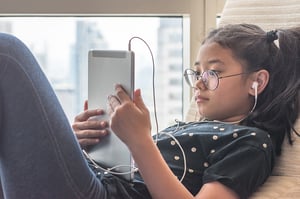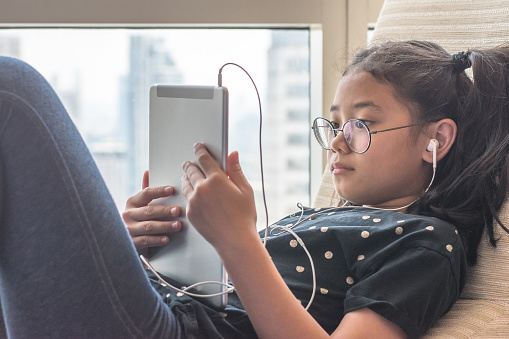“When wisely chosen and used well, technology has many benefits for children and adolescents . . . There are some wonderful programs available that inspire and educate and delight children and adults. And technological adaptations can be life-changing for a child with special learning needs, whether giftedness or learning problems.” (Psychology Today) 
Perhaps you’ve seen technology usage recommendations issued by the American Academy of Pediatrics, and they’ve been pretty strict. They’ve advised against allowing your child to have any screen time whatsoever before he or she is 18 months old, with no more than one hour of “high quality programming” daily for children aged two through five. They’ve relented, at least somewhat, but still warn parents that some television shows, apps, games and so forth are more appropriate, developmentally speaking, than others for young children—and that time limits are still crucial.
To add value to young children’s experiences with technology, Child Mind Institute recommends that you participate right alongside them. This is called “joint media engagement,” as family members interact while watching a show or playing with an app-based game together. Here’s another way to provide screen time in a positive way: communicate with friends and other family members through technology. When your young child talks to Grandma, for example, through Skype, this allows the family to use the best of technology as loved ones connect.
HealthyChildren.org provides other suggestions for parents, including that you know what your child is watching and that you set reasonable limits, making “unplugged play a daily priority.” They also offer resources to help your family create your own unique media usage plan, one that enhances your “family values & parenting style.” Whether this means playing games together or otherwise using technology “thoughtfully & appropriately,” when creating your Personalized Family Media Use Plan, you can focus on using technology in line with your own purposes.
The site also shares two ways you can make technology usage a plus for your family, including that it provides you with ways to be a good role model as you use good manners online. If, for example, a child sees a parent get angry when he or she is interrupted while playing games online, that teaches them one thing. If, though, young children see parents happily interacting with their family members as the games are being played, then that sends a totally different message.
HealthyChildren.org also suggests that parents do their own homework—meaning that they don’t automatically assume the more than 80,000 apps labeled as educational are of the equally appropriate quality for their own young children. Common Sense Media, among other organizations, can provide parental guidance.
Play of the Future
Parents.com shares an intriguing perspective: that children see technology and physical toys in much the same way, as “tools for creativity and play.” As children are born into worlds where technology is front and center, they don’t even have the context, necessarily, of separating the concepts of physical toys and digital ones.
As an example, they discuss a boy who first created an elaborate theater using Legos. He then placed Lego people in chairs, and then got an iPhone, placing it in front of the Lego theater, and pushed play. Then, he and his dad—and the Lego people—all watched a movie together.
Because of this kind of integration, one expert suggests we’ll someday look back at the idea of monitoring screen time and laugh. In other words, with healthy development of children and play, it’s not where play takes place. Instead, it’s what the child is actually doing during play—and, if he or she is actively creating, rather than being a captive/passive audience, then all can be good.
Other possibilities for the future include how young children may someday collect soil from outside, dump it on a tablet screen and discover the chemical makeup of the soil. Or, he or she may be able to see a flower on a screen, but in ultraviolet colors that reveal how a bee sees pollen.
“With such possibilities within our children's reach,” the article concludes, “the future for play—and our kids—is very bright indeed.”



